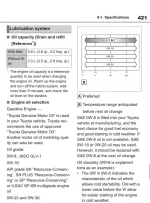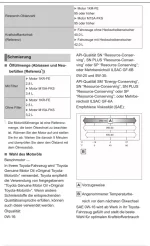You are using an out of date browser. It may not display this or other websites correctly.
You should upgrade or use an alternative browser.
You should upgrade or use an alternative browser.
Toyota Crown takes 0w8 oil
- Thread starter UG_Passat
- Start date
At least 5W-30 still has the largest market share of any viscosity currently.To paraphrase Patrick Henry…
Give me 0w-20 or give me death …
I've really lost confidence in automakers who are using 0W-16/0W-8.
0W-8 has a HTHS of 1.7. Incredible how some automakers are ignoring HTHS and recommending oils with
HTHS of 1.7 in their flagship $40,000 sedans. This is a disqualifier for me. I won't ever buy those automaker's cars in the future.
Last edited:
or even better, give me 5W-30 or give me death.
being forced to use 0W-16 or 0W-8 is worse than death (LOL).
At least 5W-30 still has the largest market share of any viscosity currently.
I've really lost confidence in Toyota, will avoid all Toyotas for the rest of my life.
Let some other buyers deal with the 0W-16/0W-8 saga. Will never affect my vehicles.
I think we get it.
I respect the thin crowd on this forum. I read AEHas's thick versus thin long posts with respect.
We're all on the same side here. We just want to do what's best for our engines.
My plan for maximum engine and transmission protection is to only use:
Engine Oil: A synthetic 5W-30 oil with HTHS 3.2 to 3.6.
Transmission Fluid: Amsoil Synthetic Signature Series ATF with Viscosity at 100C = 7.5.
Oil Filter: Fram Ultra with 99%+ efficiency at 20 Microns.
Air Filter: Fram Ultra with 99%+ efficiency at 20 Microns.
Oil change interval: 4,000 miles.
We're all on the same side here. We just want to do what's best for our engines.
My plan for maximum engine and transmission protection is to only use:
Engine Oil: A synthetic 5W-30 oil with HTHS 3.2 to 3.6.
Transmission Fluid: Amsoil Synthetic Signature Series ATF with Viscosity at 100C = 7.5.
Oil Filter: Fram Ultra with 99%+ efficiency at 20 Microns.
Air Filter: Fram Ultra with 99%+ efficiency at 20 Microns.
Oil change interval: 4,000 miles.
Last edited:
0w8 is like skittles and 0w30 is salad. Lollike your body your vehicle only gets what is put into it!! never concern of mine as i will NEVER own a newer modern techy vehicle!!
Time will tell if the we see 2023 Toyota Crown's that are speced for 0W-8 as used cars on Craigslist 10 years from now with 200k miles.0w8 is like skittles and 0w30 is salad. Lol
It's an unknown. In my opinion Toyota is taking a big risk. I hope it works out for them and their customers.
Last edited:
Toyota's using 8W will be perfectly fine. People were screaming about 20W being "water" when it was first used, and boy were they wrong. Now 20W is seeing 300K miles with no oiling issues. Circle track engines are exclusively using 20W oils at 9K rpm with stellar wear results upon disassembly after multiple race weekends.
Toyota's 10K oci is working very well. We have personal vehicles on this schedule. One is a 4R with almost 200K miles using 20W and runs like new with solid compression numbers. The other vehicle is using 16W, same result.
Fortunately the old school oils are being phased out. 10W-30 is now primarily a diesel oil, 10W-40 is a relic, 20W-50 is on life support...even at drag strips, minus a few old timers.
Another convenience advantage is the oil pours much faster now, no more waiting for that stringy slow stream to stop. They pour closer to whole milk now, dump and toss the container instantly.
Toyota's 10K oci is working very well. We have personal vehicles on this schedule. One is a 4R with almost 200K miles using 20W and runs like new with solid compression numbers. The other vehicle is using 16W, same result.
Fortunately the old school oils are being phased out. 10W-30 is now primarily a diesel oil, 10W-40 is a relic, 20W-50 is on life support...even at drag strips, minus a few old timers.
Another convenience advantage is the oil pours much faster now, no more waiting for that stringy slow stream to stop. They pour closer to whole milk now, dump and toss the container instantly.
High Temperature High Sheer >= 3.2 and higher Moft still provides more protection during high termperature high RPM situations like climbing a long incline. Also changing the oil every 4k to 5k miles before oil sheers and protection decreases is important. If CAFE didn't exist, no one would be using 20 weight or thinner oils. The proof of that is the same engines speced in the US for 0W-20 or 0W-16 are speced for 5W-30, 5W-40 in Europe and Australia since those locations don't have CAFE, so no benefit to going thinner than 30 weight. Lower HTHS will always cause more engine wear.Toyota's using 8W will be perfectly fine. People were screaming about 20W being "water" when it was first used, and boy were they wrong. Now 20W is seeing 300K miles with no oiling issues. Circle track engines are exclusively using 20W oils at 9K rpm with stellar wear results upon disassembly after multiple race weekends.
Toyota's 10K oci is working very well. We have personal vehicles on this schedule. One is a 4R with almost 200K miles using 20W and runs like new with solid compression numbers. The other vehicle is using 16W, same result.
Fortunately the old school oils are being phased out. 10W-30 is now primarily a diesel oil, 10W-40 is a relic, 20W-50 is on life support...even at drag strips, minus a few old timers.
Another convenience advantage is the oil pours much faster now, no more waiting for that stringy slow stream to stop. They pour closer to whole milk now, dump and toss the container instantly.
Yes, you can get away with using thin oils in most applications, but why take the risk.
Ìf I go up some steep never ending hills with 8 people in my minivan and the AC on during a cross country vacation going up into the mountains,
I dont want to worry that I might have just caused some engine wear that the thin 20 or 16 weight oil
allowed due to not enough film strength on the piston ring or bearings which might have reached 150C even though average coolant temperature was 100C.
That is why I only will use thick 5W-30 oils.
I’m just waiting for some of that sweet, sweet 0W-0 to come out. It’s gonna be awesome!
I agree! I will now be able to start my Toyota in -90F weather.
Anytime MOFT heads closer to zero, there is additional "risk" of added wear when the AF/AW tribofilm ("film strength" of the oil) has to take over to mitigate wear on contacting, rubbing surfaces.There is no "risk." I've seen high load testing on engine bearings and surfaces and an incline has no measurable impact.
Sure, over the course of 400K miles. Most people don't even hit 200K. The proof is already in the pudding.Anytime MOFT heads closer to zero, there is additional "risk" of added wear when the AF/AW tribofilm ("film strength" of the oil) has to take over to mitigate wear on contacting, rubbing surfaces.
Some people like wear protection headroom, some don't care. I only care about by stuff, don't care what others do ... use WD-40 in an engine if you want.Sure, over the course of 400K miles. Most people don't even hit 200K. The proof is already in the pudding.
Last edited:
The incline is creating the "high load" condition. Like towing a trailer up a steep hill. The greater the incline the greater the load...how can there be no measurable impact if the incline % is loading the engine?There is no "risk." I've seen high load testing on engine bearings and surfaces and an incline has no measurable impact.
Hey I resemble that comment.Sure, over the course of 400K miles. Most people don't even hit 200K. The proof is already in the pudding.
You can keep your pudding. I'm hopefully on my way to 400k miles and I'm running 0w40 in my Silverado work truck.Sure, over the course of 400K miles. Most people don't even hit 200K. The proof is already in the pudding.
Keep in mind it’s a hybrid - and typically hybrid engines don’t see high loads or a lot of idling, but they do see lots of start-stop. A Toyota hybrid engine rarely ever sees redline, and there’s measures taken to ensure the ICE side warms up quickly to primarily reduce emissions but to get to operating temp quicker.A 4,000 pound car (Toyota Crown) speced for 0W-8. HTHS probably < 2.0.
I don't think I'll ever want to buy a new Toyota (as nearly all of their new model's are speced for 0W-16 or 0W-8).
And they use the variable electric oil pumps which makes sure engine oil pressure is always at low end of what's adequate
to save tiny fractions of gasoline. I doubt any of these new Toyota's will make it to 200k miles.
I care for a car that sees a lot of use as an Uber and while I can get away with 0W-20, I chose to run a thicker oil since it does fall into “severe” service, into Toyota’s wording that thicker oil can protect better for those use cases. Toyota does for the new Dynamic Force engines say thicker oil is A-OK for the rest of the world. The oil pump is not electric - the volute chamber is controlled by a PWM solenoid. it does leave their Japanese/Thai/Kentucky/W. Virginia engine plants with 0W-16/8 however.
Similar threads
- Sticky
- Replies
- 2
- Views
- 1K
- Replies
- 23
- Views
- 6K
- Replies
- 4
- Views
- 2K



